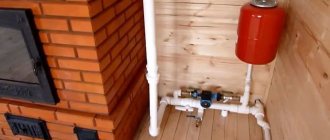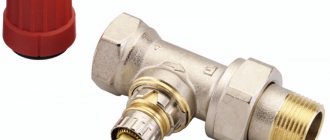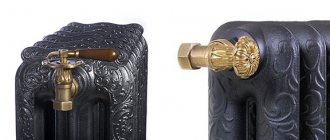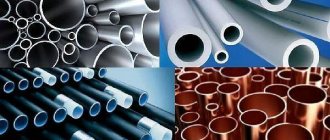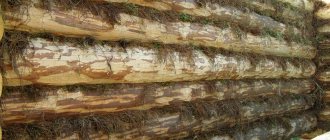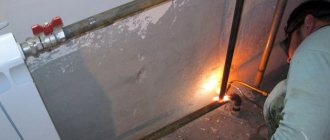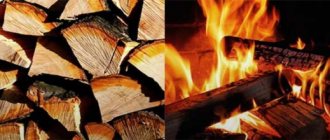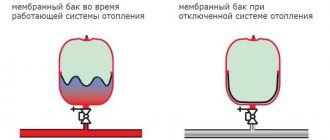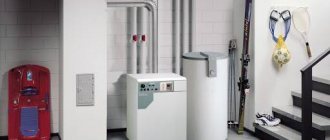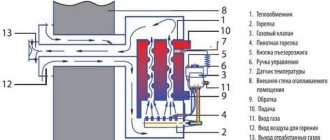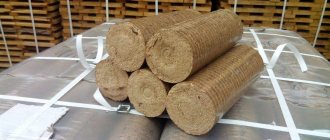Good day, dear reader! Are you familiar with the situation when the faucet in the kitchen or bathroom breaks down and starts leaking constantly?
If it is not repaired or even replaced in time, then you can flood not only your apartment, but also your neighbors below. In order to be able to stop the water supply during repairs, a water valve must be installed at the entrance to the apartment. It is also advisable to have a separate valve-type shut-off device in front of the washing machine and each plumbing fixture, so that in the event of an emergency, only a certain area is disconnected from the water supply system, and not the entire water supply.
What types of valves are there?
The valve is a shut-off and regulating device mounted on a threaded spindle that closes the passage in the horizontal plane.
The technical conditions for its manufacture are regulated by GOST 12.2.063-81, GOST 5761-74. The water valve is available in several modifications, differing in:
- housing designs (direct-flow, pass-through, corner, mixing);
- method of sealing the joint between the cover and the movable element of the shutter (bellows, stuffing box);
- location of the running nut (submersible or external type nut thread);
- material for manufacturing the main elements (brass, cast iron, steel);
- method of fastening to the pipeline (flanged, coupling, pin-type, fitting, welded fittings);
- designs of the locking element (ball, valve, cork, wedge);
- type of force transmission to the working mechanism (manual control, electric drive).
Product classification
The water valve is classified according to a number of different characteristics, which include:
- Type and design of the locking device.
- Material of manufacture.
- Features of connection with water or gas pipelines.
Based on the type and design of the locking device, valves are divided into the following types:
- Valve
- Cork or cone.
- Ball.
Let's find out the main features of each type of valve, and also determine their purpose.
Valve devices
The valve valve is also called a valve tap, since the body of the product is divided into two parts by horizontal and inclined partitions. The design of the product with an inclined partition has a hole that has a groove for the valve. This hole is called a saddle.
The valve is part of the rod, which is located at the bottom of the product. An elastic gasket is inserted into the design of the product, resting against the saddle. By means of this stop in the seat, the supply of fluid flowing through the device is blocked. At the top, the rod is equipped with a thread that connects to the threaded connection of the seat nut. Using this threaded connection, the valve is raised and lowered, thereby shutting off and regulating the pressure of the supply fluid.
Products of this type have advantages and disadvantages. The advantages include:
- Withstand high pressure.
- Adjustment of water volume and pressure.
- Easy to operate.
- If the locking device fails, it can be replaced.
The disadvantages of such a device are:
- High rate of abrasion of the gasket, since with frequent opening and closing of the device, contact of rubber with metal occurs.
- Relatively short service life.
- To completely shut off the liquid supply, you need to rotate the flywheel for a long time.
Cone type product
A cone valve is a type of valve product. The differences between the two devices lie in the design of the locking mechanism. If in the previous version the locking mechanism is presented in the form of a partition, then in this design the device has a plug in the form of a cone. When the rod rotates, the shut-off valve is lowered into the hole in the partition, thereby stopping the flow of liquid.
The advantages and disadvantages of this type of product are similar to those of a valve type valve. The cone valve has the following structure as shown below.
Ball type device
The operating principle of this type of valve is completely different from the functioning of previous options. If previous products provide shutoff of water perpendicular to the pipeline, then with a ball-type device everything is different.
The main locking device is a ball, which has a through slot proportional to the fluid flow. Shutting off the liquid supply is ensured by moving the ball with the slot to a perpendicular position. Such valves are also called gate valves.
The advantages of such products include:
- Simplicity of design, which allows the device to be used for a long time.
- Tightness of the structure. Only the shut-off ball is in contact with water, which also affects the long service life of the product.
- Shutting off and opening the liquid supply is done by turning the handle 90 degrees or half a turn. Due to the rapid shut-off of the liquid supply, such devices are also called reversible floors.
The disadvantages of the types of valves under consideration include:
- Inability to repair a water supply ball valve. In Chinese products, the integrity of the connection between the handle and the locking ball is compromised. This causes the handle to continue to rotate and the ball to remain in place in a stuck position.
- Inability to regulate fluid flow. It is possible to regulate the flow of liquid using such a product, but in this case the manufacturers do not guarantee the long service life of the device.
Design features of the case
Valves, depending on the shape of the body and the method of installation on the pipeline, can be:
- direct-flow - in them the flow of transported liquid moves through the body from inlet to outlet without changing direction, the spindle axis is located at an angle to the axis of the passage hole. This design helps straighten the flow and reduce hydraulic resistance, but increases the working stroke of the valve, the parameters of the construction length and the weight of the product;
- pass-through - a product with the same direction of flow of moving water at the inlet and outlet and the axes of the inlet and outlet pipes shifted parallel to each other. Passing through the valve body, the water flow is forced to make at least two turns at right angles, which leads to the formation of high hydraulic resistance and the formation of stagnation zones;
- angular - in them the flow turns by 90º only once, therefore the level of hydraulic resistance is lower. Such products have restrictions on the area of use - they are placed on the pipeline plan only on its rotating sections;
- mixing - in them the adjustment of the proportions of water occurs due to the mechanical rotation of the internal elements of the body. Designed to shut off and mix cold and hot water flows.
Types of control valves
Based on the type of valve mechanism, the valves for monitoring pressure in the pipeline are divided into the following devices:
Seat valve
Cell valve
Spool valve
Diaphragm valve
- Saddle. The functions of the working element of the valve are performed by a plunger, which in its design can be disc-shaped, needle-shaped or rod-shaped. It moves through one or two valve saddles, reducing its flow area. Single-seat models are installed on small-diameter pipelines, while valves with two seats are in demand on large-sized pipelines.
- Cellular. When using fittings, control and regulation of pressure in the pipeline occurs due to the valve, which has the shape of a hollow cylinder with radial perforation. It moves along a cage that acts as a guide element and a passage unit. Thanks to the design nuances, cage valves are characterized by low vibration and low noise levels.
- Spool valves. Regulation of the parameters of transported substances is carried out using a spool, which rotates at a certain angle. Controlling the spool valve does not require much effort, since the transported liquid and gaseous substances offer almost no resistance when moving the valve locking mechanism. However, such fittings are not able to provide complete tightness, so they should not be installed on high-pressure lines.
- Membrane. The cross-section of the pipeline in fittings of this type is closed using a membrane made of elastic rubber or fluoroplastic. To avoid errors during regulation, diaphragm valves are equipped with special elements that provide control of the position of the rod. Among the advantages of the valves are resistance to corrosion and aggressive environments, which allows them to be used in the petrochemical industry. Diaphragm valves are available with a hydraulic or pneumatic drive, which can be built-in or remote.
Shut-off and control valves are also in demand when installing pipelines for various purposes, which, in addition to changing the flow of transported substances, make it possible to completely shut off their circulation. The functions of a locking device in the valve are performed by a plunger. When in full contact with the seat, it provides a hermetically sealed shutoff, and in partial contact, it reduces the passage opening.
Locking elements. Principles and structure
Water taps are available with different shut-off element configurations: ball, valve, plug and wedge designs.
Ball valve
A ball valve is a valve whose valve has a spherical surface.
Its design consists of the following elements:
- housings. It can be made in an all-welded or dismountable version. Valves with a solid body weigh less, are cheaper, but cannot be repaired. Collapsible products have a more complex design, are more expensive, but can be repaired;
- constipation in the shape of a metal ball. Has a passage opening with a cross-section smaller than or equal to the nominal diameter of the valve, can be floating or fixed;
- a movable spindle that rotates the locking part;
- removable handles;
- fluoroplastic end rings ensuring a tight connection between the body and the polished ball.
The ball valve has a through hole, the axis of which is parallel to the direction of the transported liquid. The rod is rigidly fixed, and together with the ball forms a rotating axis, which, when the valve is closed, is in a perpendicular position relative to the direction of movement of the water flow. When the rod is rotated 90º to the axis, the holes of the ball and the water flow coincide and water is supplied.
Valve
The shut-off assembly of a valve valve includes a threaded rod and a piston (valve). The cross section of the piston corresponds to the diameter of the passage hole in the product body. When the position of the valve changes, it is screwed into the seat nut, and as a result, the flow of the moving medium is blocked.
The valve can be used not only as a shut-off device, but also to regulate the volume of water supply.
Klinova
A wedge valve is a water valve whose movable valve part has the shape of a plate (wedge) tapering towards the end.
When the handle is turned to the “closed” position, the wedge is pressed tightly against the seat in horizontal planes parallel to the direction of flow, which at this moment is forced to bend twice at a right angle.
Suberic
With a plug valve, the flow is blocked by a cone-shaped plug attached to the stem. Under the influence of the handle, the rod lowers and the plug enters the passage hole, tightly blocking it.
Worm
The elastomer gasket is pressed tightly against the seat under the influence of a worm-type mechanism, which is activated by a handle - a flywheel.
In the open position of the valve, the rod with the gasket rises and the passage for water opens.
Ceramic
Inside the body of such a valve there are two plates with oblong-shaped holes. One of them is fixed motionless in the body cavity, the other is attached to the spindle. When the handle is turned, the movable plate moves until their holes coincide and a passage opens for the flow of water.
Electrically operated valves
Shut-off valves equipped with an electric drive are installed mainly on large-diameter main pipelines.
They are controlled in automatic mode remotely, and can also be configured for manual control using the steering wheel. The electric drive consists of two main components - a motor and a gearbox; for remote control it is equipped with indicators and position sensors of the shut-off element, and with special limiters to prevent overloads. For attachment to the valve, a flange or coupling type of connection is used.
Valves
Products of this type are used on production lines and in transport pipelines for industrial purposes. The valve is manufactured in the following versions:
- with manual control;
- with electric drive in standard and explosive versions;
- with hydraulic drive.
On large-diameter shut-off valves with manual control, a gearbox with a worm, bevel or cylindrical gear is installed to reduce the force on the flywheel. If the valve spindle is located horizontally, the electric drive is mounted on a support, the worm and roller bearing are thickly lubricated with oil.
Main characteristics:
- conditional pressure, P, MPa (kgf/sq. cm): 0.16 (1.6) – 25.0 (250);
- nominal diameter, D, mm: 50–2000;
- working environment temperature, K (°C): +213 (-60) − +838 (+565).
Mounting methods
Water valves can be connected to the process in different ways: fixed using special elements or mounted by welding.
Flange connection
This type of connection uses a special metal flange with a rubber gasket.
Loose flanges are placed on the end of the pipe and the valve nozzle, a gasket is installed between them, then the entire assembly is bolted together.
Coupling fittings
The connecting pipe has an internal thread with a fine pitch, and the outside is shaped like a hexagon for ease of use with a wrench. The coupling is screwed onto the thread and sealed with flax strands or FUM tape.
Tsapkova
This method of fastening is characterized by the presence of an external thread at the end of the connecting pipe and a collar at the end of the pipeline.
The valve branch pipe is pressed against the pipe with its end and secured in this position using a union nut. The tightness of the connection is ensured by a metal gasket and special lubricants.
Choke
The fitting is a short piece of pipe (bushing) with internal threads at both ends. With this type of connection, the connecting ends of the fittings are screwed onto the pipe and secured with a union nut.
Welding
This is a one-piece type of connection, the tightness of which is ensured by welding.
Types by connection principle
The ball valve differs in the material used in its manufacture, and also in the principle of connection to the pipe.
Coupled
A ball joint water tap is a design with threads at the ends. This type is used for industry and housing and communal services. Diameter range 8 – 100. The body is made of bronze, steel and stainless steel.
The advantages of this type of product include low weight, length, and low cost. The disadvantages include the difficulty of repair and maintenance.
Carving is divided into several types:
- VN-VN - internal thread on both ends of the product;
- NAR-NAR – external thread on both sides;
- Fitting - inside thread with fitting;
- VN-NAR - one thread is inside, and the other is outside;
- With the American one there is a thread inside on one side, and a union nut on the other.
Flanged
This type connects with a return flange. Diameter range from 15 to 800. The body is made of cast iron, steel and stainless steel.
Among the advantages of this type are:
- Ease of installation and maintenance;
- Can be used for any pressure indicator.
Disadvantages of this connection:
- Large weight and size;
- The bolt tie becomes loose, which means that over time this will lead to a decrease in tightness.
Welding
The ends are made specifically for welding. They produce products in sizes 10 – 800. The material is made of steel and stainless steel.
Advantages of the welding product:
- Absolute tightness;
- Weight and length are less than flanged ones.
Disadvantages of this type:
- There is no possibility of service;
- Difficult to install;
- Difficult to replace.
Manufacturing technology and materials
Various materials are used to make the valve:
- Brass. The brass product is characterized by its small dimensions, light weight, corrosion resistance and long service life. It can be installed in both cold and hot water supply systems made of steel and plastic pipes. The disadvantage is the high cost of such products.
- Cast iron. Valves made of cast iron have a fairly large mass, but are reliable, capable of withstanding increased levels of pressure, and resistant to various types of deformation. They have a low price, so they are often used for the construction of water supply systems in private and apartment buildings, country houses and garages.
- Steel. For steel products, instead of a handle, a wheel is installed on the body, by turning which you can adjust the pressure level or stop the pressure of the moving medium. They are lighter than cast iron, have a simple design, are repairable, and can be used in heating systems with higher operating temperatures and pressures, as well as in networks where there is a risk of water hammer.
Expert advice
- It should be borne in mind that you cannot put plastic on the input - if it fails, it will take a long time to change it. Cast iron and steel rust – these materials should be discarded.
- Do-it-yourself installation of any gas pipeline elements is prohibited - and it is better not to experiment for safety reasons.
- Copper fittings are used for copper water supply systems. Soldering copper pipes and fittings is difficult - best left to a specialist.
- You should not use tow during installation - modern FUM tape insulates the joints more reliably and allows you to easily unscrew the threaded connection in the event of a breakdown.
- If it is necessary to weld a metal-plastic pipe, it is necessary to remove the top two layers of polypropylene and aluminum foil (there is a special device for this - a shaver). You cannot weld plastic at subzero temperatures.
- If you are replacing a product on a threaded connection and it does not unscrew, you should use a special thread lubricant (for example, WD-40).
- When installing the tap, the direction of liquid flow must coincide with the arrow on the tap.
What types of taps/mixer valves are there?
Depending on the purpose, there are 4 main types of water taps: valve, single-lever, with a thermostat and sensor.
Valve
These mixers are considered the most common devices.
They come in two types:
- with one valve. Such faucets can supply only one type of water - cold or hot. Used primarily for installation in the kitchen or washbasin. The body of the single-valve faucet is made of copper or brass alloy. The locking mechanism - in the form of a ceramic or worm-type valve - axle box is driven by a valve;
- with two valves. Their device includes a brass body with a chrome finish, two valves that control the cartridges (faucet - axle box).
Due to the operation of the cartridges, the pressure and temperature of the water are adjusted. The spout, depending on the modification of the mixer, can be integral with the body (not rotating) or freely rotate in different directions. Two-valve mixers are designed for mixing hot and cold water;
Single lever
A single-lever faucet has only one handle (lever), with which you can adjust the intensity of cold and hot water supply. The pressure can be increased by raising the handle up.
The temperature is adjusted by turning the lever left or right; to completely shut off the water, the handle must be lowered down.
With thermostat
This is an innovative type of device. The temperature and intensity of water flow are adjusted by setting a certain indicator on a special thermostat scale.
Contactless
The design of such mixers includes special sensors, the operating principle of which is based on the reaction of infrared rays to heat and movement.
Therefore, as soon as you bring your hands close to this mixer, it immediately works. Most often they can be seen in public places: bathrooms of airports, train stations, entertainment centers, healthcare facilities, etc.
ball or valve Find out what the essence of the choice is.
The choice of shut-off valves for residential use cannot be underestimated. It is hardly worth saying that not only the absence of problems, but also the comfort of operation fully depends on the reliability of the selected cranes. Below you will find basic recommendations for choosing faucets for your apartment/cottage.
Cranes in Stream Market today are presented in a wide range. The point is that you can easily purchase shut-off valves from the world's leading manufacturers of plumbing equipment. By understanding the basic selection criteria, you will protect yourself from problems with water supply and heating.
Benefits of using ball valves
Indeed, almost all specialists working in the field of organizing water supply networks or heating speak about the need to use ball valves.
This part of the water supply network has the following advantages:
However, the positive aspects mostly concern European manufacturers of shut-off valves. Note that maximum attention should be paid to the choice of the alloy from which the ball valves are made.
In addition, choosing combo solutions is not recommended. An example is the widespread Italian product, where a ball valve is connected by a permanent connection to a coarse filter.
Thus, if the shut-off valve itself fails, you immediately lose filtration in the system.
Why are they trying to avoid using valves?
The design of plumbing valves is imperfect. To open it completely you have to perform a large number of turns of the handle. While for a similar action, a ball valve requires only one movement of the hand.
The valve may get stuck. It will be almost impossible to unscrew it by hand. However, when force is applied to the valve handle using an extended lever, the threads are “licked off” and the shut-off valve can no longer be used for its intended purpose.
We have to carry out work to replace it.
The video will tell you which type of taps is best for heating radiators:
Based on materials: https://stream-market.com.ua/krany_sharovye_zapornaya_armatura
Tweet
Which one is better to choose?
Choosing a mixer is not easy. After all, you want it to be compact, reliable, firmly “sit” in the workplace, match the style of the room and not break down for a long time.
- For the kitchen, it is advisable to choose a valve made of brass, bronze, copper with a chrome or gold coating, on which grease does not linger and dirt is easily washed off. Such faucets are durable and expensive, they are not susceptible to oxidation and rust. The faucet should also have a swivel spout with a gander height convenient for washing dishes. The price of a quality product starts from 5 thousand rubles.
- For the bathroom - the faucet body and spout should be made of brass, preferably having a replaceable cartridge. This can be a ball mixer equipped with a single lever handle or a two-valve tap. Many people prefer a ceramic water tap, i.e. with ceramic cartridge. The sealing element in it is a ceramic ring. Such products withstand the effects of hot water better, adjust more smoothly than taps with a rubber seal, last a long time, and require less repair and maintenance. Of course, with such characteristics, a ceramic faucet also has a considerable price - from 4.0 to 35.0 thousand rubles (depending on the manufacturer).
- For other situations. In utility rooms and garages, an inexpensive single-valve tap will suffice. The price of such products varies from 1.5 to 3.5 thousand rubles.
Purpose
Shut-off valve (valve) - serves to shut off the flow of the working medium in the pipeline moving in one direction. Direction of movement of the working medium according to the arrow on the body. The locking element moves parallel to the flow axis.
Shut-off valves are used most often on steam and water pipelines, since they create high flow resistance, higher than gate valves. During flow, the flow bends, changes its direction, narrows, and then expands to its original size. In this case, intense vortex formation occurs.
Therefore, they are used when the movement of the medium occurs only in one direction and does not cause large hydraulic resistance. Special valves are used for manual throttling of pressure (for example, a pressure reducing valve in thermal cracking units).
It should be noted that until 1982, valves in which the valve is moved using a threaded pair of spindle and running nut were called valves. Currently, valves are also called valves with a threaded spindle and a smooth stem.
Shut-off valves must comply with the requirements of GOST 5761 (regarding gland and bellows valves, steel and non-ferrous metals), TU and KD.
Nominal pressures from PN1.6 MPa (PN16) to PN25MPa (PN250) inclusive.
How to install it yourself?
Proper installation of a water valve is important for its safe operation and longer service life. In principle, the installation itself proceeds according to the following scheme:
- The water supply system is shut off.
- Open all the taps to allow any remaining water to drain from the pipes.
- Dismantle the worn device. The choice of dismantling method depends on the type of connection of the old product:
- pin-type - use a wrench to loosen the union nut;
- coupling - by dismantling the coupling;
- flanged - loosen the bolts used to secure the mounting flanges;
- welded - a section of pipe is cut out using a welding machine.
- Clean the pipe at the installation site from residual sealant and rust;
- Install a new valve, sealing the threaded part of the fum connection with Tangit Unilok tape or thread. For a flanged valve, no sealing material is required. Unlike fittings with a collapsible type of connection, installation of a welded device will require a special apparatus for soldering pipes.
However, there are a number of nuances that should be taken into account when working:
- choosing a convenient place to install the product so that there is no interference with the movement of the lever or handle;
- The thread may need to be lengthened. If the valve is being replaced, then after dismantling the old device, you need to clean the threads of the pipe from any remaining sealing material and try to screw a new product onto it. Quite often, during operation, corrosion destroys the metal on two or three turns of the threaded part, so it is necessary to cut off the missing turns;
- The product must be installed taking into account the direction of flow of the working medium indicated on the body of this type of shut-off valve.
Installation
To install the valve, you do not need to have any specific skills. It is enough to follow the step-by-step instructions without breaking the sequence. Installation steps:
- Before installing the valve, clear space in the place where the mechanism will be installed.
- Turn off the water so that it does not interfere with work. Drain the excess liquid through the drainage system from the system. There must be separate taps for this.
- The solid pipe is cut using a cutter to fit the locking element.
- Threads are cut at the ends of the pipes using special dies. Use a wire brush to remove shavings.
- The thread is covered with a sealing thread to create a more reliable connection. Some plumbers use sealant.
- The valve is installed between the pipes and screwed onto the thread. Clamped with a wrench.
Next, the valve that held the flow of liquid opens. It is necessary to check the reliability of the connection at different pressure levels. This is how you can replace an old valve at home
It is important to ensure that the locking element is screwed onto the thread. Distortions that could destroy the integrity of the system should not be allowed
If the valve has a flange, additional pipe preparation is required. To do this, they are cut, and metal plates with holes for fasteners are welded at the ends. Next, a valve is installed between the pipes. A rubber gasket is secured between the flanges using waterproof glue. The structure is secured with bolts and nuts. Additionally, you can weld the flanges using a welding machine. The seam must be cleaned with a grinding machine and coated with an anti-corrosion compound.
Shut-off valves are necessary elements of any system working with gases and liquids. With their help, the power of liquid or gas supply changes and the flow is completely blocked. Installation can be carried out by anyone, knowing the step-by-step instructions.
